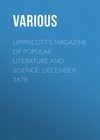Loe raamatut: «Chambers's Edinburgh Journal, No.307»
TRACINGS OF THE NORTH OF EUROPE
ELSINORE – GOTTENBURG
I left Copenhagen for Elsinore on the last day of June, with two companions, in a char-a-banc; a rough but not inconvenient kind of carriage drawn by two horses. We took the route by Fredericksborg (different from the Fredericksberg already mentioned), in order to visit that most distinguished of all the Danish palaces. The king was living in it at the time; but this was understood to present no difficulty. The life of Frederick VII. is remarkably modest and unobtrusive. Allowing his ministers to govern according to the best of their judgment, he is content to live in the manner almost of a private gentleman. It was stated that at this time, when half the sovereigns of Europe were in the agonies of a revolutionary crisis, the attention of the Danish monarch was chiefly engrossed by some ancient sepulchral tumuli found in his neighbourhood. So great is his disrelish of royal state and parade, that he can only with difficulty be induced to come occasionally to town to give audiences and attend reviews. Yet Denmark is a year old in a constitution which grants something approaching to universal suffrage. Very probably the Sleswig-Holstein war is what has secured this internal peace. Uniting in this external object, the people have escaped as yet the danger of falling together by the ears about progress and reaction. So for once a democratic movement has not been attended by a crop of folly and outrage.
The country passed over in our drive is composed of the tame undulations usual in the chalk formation, varied only by a few lakes and some fine woods. We snatched an interval required for resting the horses to see the queen-dowager's palace at Lundby, which we found to be a plain building situated amongst some pleasant groves, but in no way remarkable, except that the domain was open at all points to any one who chose to leave the high road by which it is skirted. We walked over the grounds, and penetrated into the garden, asking no leave, and meeting no resistance or challenge – a proof not so much, I apprehend, of any special liberality in the royal possessor, as of great harmlessness in the people; for certainly without that, no such indulgence could be extended. The inferiority of the place in point of trimness to similar places in England, and the meagre show of plants in the garden, were remarkable. That fastidious mowing, and paring, and cleaning, which is continually going on round a country residence in England, is unknown in the north of Europe.
All along our way to Fredericksborg I observed heaps of granite and gneiss boulders, ready to be broken up for the repair of the roads. They were to me an interesting set of objects, as being my first introduction to the grand Drift Formation of the north. To most readers it will be enough for the present to say that they are masses of stone belonging to the granitic and gneissic countries of northern Sweden and Finland, which have been carried southward, probably for the most part by icebergs floating in the sea by which this region was once overspread. They are found imbedded in the clayey and gravelly covering of the country, or encumbering its surface; and now the farmers are allowed something for carting them to the roadsides, that they may be pounded down by the disciples of Macadam. The kirb-stones, which form the only approach to a pavement in Copenhagen are from the same source. I examined many of the wayside heaps, as well as those presented in gravel-pits, and found a few with traces of striation, denoting their having undergone rubbing in the transport; but these were rare objects. The cultivated land seems now pretty well cleared of them; but they still abound in forest ground. The sand of the aforesaid gravel-pits is in many places stratified, marking the deposition by water; but I nowhere could detect shells.
At length the pinnacles of Fredericksborg began to appear over the dull landscape, and we speedily found ourselves seated in the village inn at a very tolerable dinner. When this was concluded, we sauntered to the palace, which we found to be a huge brick edifice of the Elizabethan style, forming three sides of a square, with detached masses and courtyards, the whole closely surrounded by water. It is one of the many memorials of the magnificence of the fourth Christian, but was built on the site of a former palace; and amongst the few traces of the original left, is a small island covered with shrubbery. The shrubbery had been planted by Frederick II., the father of Christian, in commemoration of the son having been born on the spot; and under a feeling with which we can all sympathise, the reforming king left this shrubbery untouched. It is said that the new palace took fifteen years in building. Here, again, one wonders that so small a state could at that time furnish funds for the erection of such sumptuous edifices. The unchecked authority exercised by its princes is the only explanation of the mystery. They seem to have regarded palace-building as a legitimate amusement for their leisure hours, and to have been under no sort of scruple as to the sufferings of their people in furnishing the requisite funds. A Danish king, in the last century, told his young queen, in a fit of gallantry, that if she should kill a deer in the chase, he would build a palace on the spot. Such, I am told, was the actual origin of one of the numerous palaces which now adorn the country. To find ourselves now in this gray, old-fashioned château, and be told that the king lived in it, seeing as we did no trace of any state or pageantry whatever, and scarcely any mark of the place being inhabited at all, raised some curious speculations in our minds as to the change of the relations of monarch and subject since the days of Christian IV.
The grand sight of Fredericksborg is the royal chapel, forming the lower floor of one side of the square. It is a superb specimen of that mixture of Grecian and Gothic which prevailed at the end of the sixteenth century; no grandeur of plan, but infinite ornament of detail, gilt reliefs (especially on the ceiling), carvings, and fine inlaid woodwork. The pulpit has pillars of silver, and the altar-piece glows with golden images and sculptures. 'The Swedes,' says Feldborg, 'took away twelve apostles in silver, leaving the figure of Christ, which was formed of the same metal, to preach the Gospel at home, as they wickedly expressed themselves, but declaring that his apostles should do so abroad.' The screened recess for the royal family still contains a range of chairs with wrought seats, which must be coeval with the chapel, as they contain Christian's initials. There is even still the same charity-box at the door, into which this grand old prince must have popped his donations as he passed to worship; for it, too, bears his initials. The coronations of the Danish kings take place here, and this has led to an unfortunate modernisation being effected at one end of the chapel for the accommodation of the throne, with seats for the knights of the Order of the Elephant. In every other particular it is preserved exactly as it was in the days of the founder. I may remark that the shields of the living Elephantine knights adorn the gallery. When they die, these symbols of their glory are removed to a clean, well-kept crypt beneath one of the angles of the palace, where the whole series for the last two centuries may be seen. This is at once a curious historical study and a touching lecture on the transitoriness of all human grandeur.
Over the chapel, and therefore occupying the same area, is the Banqueting-Hall, certainly a most magnificent apartment, being no less than 150 feet long, and of proportionate breadth, though generally thought to be a little deficient in height. This large room is beautifully paved with diced marble, and is covered all over with gilt and painted ornaments, particularly in the ceiling, while each space of wall between two windows contains a portrait of some monarch which had been presented to the Danish sovereigns. The ceiling alone, which is said to have been the work of twenty-six carvers for seven years, might detain a curious visitor for a day, since there is scarcely a familiar animal, or a trade, or art, which is not represented in it. In one compartment you may study the business of Distillatio; in another that of Impressio Librorum, and so forth. One sees in this and similar places many valuable memorials of the things of a former age, which he cannot but regret to leave after only a hasty and superficial inspection. I am convinced that a painstaking and leisurely person, who could take accurate drawings of such objects, would, in the course of a few years' rambles over Europe, acquire the means of producing almost a complete resuscitation of our mediæval ancestors in their dresses, habits, and all other external circumstances.
When we had satisfied our curiosity with the Fredericksborg palace, we returned to the inn, and speedily resumed our char-a-banc, but with fresh horses. I observed with some surprise that the driver, in passing out of the town, deemed himself at liberty to take a short cut through the half-ruinous gateways and rain-bleached courts of the palace, notwithstanding the presence of royalty within the mansion. We found some fine woods extending from the palace in this direction, and peopled with deer. A short drive brought us to another palace, called Fredensberg, more modern than the last, and with some pretensions to notice. But we were too much satiated with such sights to care for an inspection of Fredensberg, and we therefore passed on to Elsinore, where we arrived betimes in the evening.
An Englishman usually approaches this town with his mind full of Shakspeare and Hamlet, and an eager expectation to see places hallowed by association with the name of him of the inky cloak: supply naturally follows demand, and hence it is not surprising to find that a place called 'Hamlet's Garden' has been 'got up' in the neighbourhood, and established as the scene of the murder of the royal Dane. Not being disposed to have much faith in the reality of a northern prince of the fourth century before the Christian era, I entered Elsinore with comparatively sober feelings. It is a very ordinary-looking mercantile town of 8000 inhabitants (yet the fourth in Denmark), situated on a low plain beside that Sound which has originally given it consequence. Not much less than a hundred vessels of all flags lay in the calm sea in front, waiting for wind, or till they should pay their dues to the king of Denmark. It is admitted that L.150,000 per annum are thus extorted under favour of the cannon of Cronberg Castle, which raises its huge form near by, like the beggar in 'Gil Blas,' whom the reader may remember described as having his gun presented on a pair of cross-sticks to enforce a demand neither less nor more justifiable. It is certainly surprising that a system so little different from the predatory practices of the Rhenish barons of the fourteenth century should still be found in vigour. I am afraid that my only true English associations with the place referred to things at which the Shakspearian enthusiast will scoff – to wit, James VI. dating during his honeymoon from Cronberg, 'quhair we are drinking and driving ower in the auld maner,' and his descendant, Queen Matilda, here sighing over the lost peace which was never more to be hers.1 The mind is sometimes strangely perverse and wayward, and I often find myself interested in things for reasons sufficiently trivial. For instance, while passing through the fosses and walls which surround this hardy fortress, and while my companions were probably lost in admiration of its stately proportions, I could not help recalling a passage in Spottiswoode the historian, where, speaking of James's winter in this castle, he mentions with complacency there being no such thing as a quarrel between the Scotch and the Danes all the time, a circumstance the more wonderful, says he, 'since it is hard for men in drink, at which they were continually kept, long to agree.' After all, Cronberg is only a great quadrangular palace in the centre of a set of ordinary fortifications. The casemates in the walls are usually, however, a subject of curiosity, in consequence of a legend thus related by a native writer: – 'For many ages the din of arms was now and then heard in the vaults beneath the Castle of Cronberg. None knew the cause, and there was not in all the land a man bold enough to descend into the vaults. At last a slave who had forfeited his life was told that his crime should be forgiven if he could bring intelligence of what he found in the vaults. He went down, and came to a large iron door, which opened of itself when he knocked. He found himself in a deep vault. In the centre of the ceiling hung a lamp which was nearly burnt out; and below stood a huge stone-table, round which some steel-clad warriors sat, resting their heads on their arms, which they had laid crossways. He who sat at the head of the table then rose up: it was Holger the Dane [a hero of the fabulous age]. But when he raised his head from the arms, the stone-table burst right in twain, for his beard had grown through it. "Give me thy hand," said he to the slave. The slave durst not give him the hand, but put forth an iron bar, which Holger indented with his fingers. At last he let go his hold, muttering, "It is well! I am glad there are yet men in Denmark."'2 What is curious, there is a similar traditionary story in Scotland, referring to a person called the last of the Pechs;3 and, if I am not mistaken, the Irish have the same legend, varied only as to the person and the locality.
Behind the town, at the base of an ancient sea-bank, lies a plain modern house called Marienlyst (Mary's Delight), which was built for the residence of the late Frederick VI. when crown-prince, and which is surrounded by a garden and pleasure-grounds open at all times to the people of Elsinore. English strangers are taken hither to see 'Hamlet's Garden' – the very scene of that foul murder which the mad-seeming prince studied to avenge; also to muse over a cicerone-made Hamlet's grave. I took a ramble here, to enjoy the physical beauties of the place, which are considerable, and to obtain a view of some celebrity from a platform above the house, where we command a long reach of the Sound and of the opposite coast of Sweden. A less hackneyed subject of curiosity is the geological character of the bank behind Marienlyst. It is a terrace of clayey sand extending for miles along the coast, at one uniform height in the fore part of about ninety-six feet above the waters of the Sound, the front descending at the usual angle of a talus of loose matter (38 degrees), to the low plain on which the town is situated. This bank has already attracted the attention of native geologists as a marine formation, the top being understood to have once been the beach of the sea, which had subsequently rolled on the low plain, cutting and carrying away matter from the bank rising above, so as to leave the talus which we now see. What struck me, however, with the greatest interest, was the perfect resemblance of the ground, in all its features and relations, to ancient sea-banks and terraces in Britain, even to the elevation of the terrace above the mean level of the sea – a point from which the Baltic, it will be recollected, scarcely departs.
On the evening of the 1st July I departed from Elsinore in the Gyller steamer, which makes regular weekly voyages between Copenhagen and Christiania, calling at Elsinore and Gottenburg to receive and set down passengers. The accommodations in the vessel are sufficiently comfortable; but the weather proving rough, my actual experiences were anything but agreeable, more particularly as I was here, for the first time, exposed to a near association with one of the most odious habits of the northern nations. I do not like to speak too plainly on such a subject; but it is remarkable, even as a physiological fact, how much salivation goes on amongst some nations as compared with the generality of mankind; and the fact of a neighbour on this occasion effecting a vociferous discharge from his throat about every minute during all the time I was awake, was scarcely less curious than his carelessness about what came of the discharge was disgusting. Early in the morning I came on deck to see the low rocky coasts of Sweden looming through the thick rain and haze. On getting into the arm of the sea which leads up to Gottenburg, I was enabled to observe the rounding of the surface of the whole of the rocks along the shore, and gazed with admiration on a phenomenon, the explanation of which has proved so puzzling. Even here the perfect independence of the effect on any connection with the sea as a cause was apparent, for the smoothed surfaces everywhere descended unbroken below the waves. For a long time nothing was to be seen on land but a tract of undulating rocky ground devoid of all asperities; but at length we began to obtain glimpses of an extensive swampy plain, where the sea terminated in the embouchure of a copious river – the Götha (pronounced Yutta) Elv. Here we found seated the thriving mercantile town of Gottenburg. We landed in heavy rain, amidst which we had to make our way on foot to the Götha Kellare (pronounced Chellara), the best inn in the place, but one strikingly beneath the character of the town. The whole affair was a most dismal initiation into Sweden; but it was soon made up to me by the welcome which I experienced from a kindhearted schoolfellow and friend settled in the neighbourhood.
Under more agreeable circumstances next day, I became aware that Gottenburg is a regularly-built town of about 30,000 inhabitants, containing a remarkable proportion of good private houses – much permeated by canals, which are crossed by rather hard-favoured stone-bridges – exhibiting on the inland side some beautiful environs, throughout which are scattered many handsome mansions belonging to the most eminent merchants. Gottenburg contains several British mercantile houses, and is very much an English town, unless that my own countrymen may be said more particularly to take the lead in its society. Iron-founding and machine-making, cotton-spinning, sailcloth-making, and sugar-refining, are the chief branches of industry, all of them conducted under the protection of prohibitory duties, the Swedes being willing to buy these articles at high prices from Englishmen who will consent to make them in Sweden, rather than purchase them cheaply in England. Accordingly, several of the Gottenburg firms are understood to be realising incomes in striking disproportion to those common among the natives; one, for instance, having cleared so much as L.50,000 in a year; though here, it must be remarked, the result was helped by a patent. These settlers are probably compensating in some degree for their monopolies by the impulse which they give to the indigenous population, noted in all time for the slowness of their movements, and their dislike to adopt new fashions and methods. There is a good, moreover, to be gained from commixtures of the people of two countries, in as far as it tends, by making them acquainted with each other, to extinguish mutual prejudice. As might be expected, some of the manufactures thus forced into prominence in Sweden are conducted under considerable disadvantages as compared with those of England. For example, a cotton manufacturer in Sweden cannot get a supply of his materials equably over the year, all communications being shut up during the seven months of winter. The consequent necessity of laying up a stock to serve through the winter, entailing a greater outlay of capital, is so much against him. On the other hand, he may save in the wages of his labourers. These trades are in the meanwhile prosperous; but I have a strong sense of the precariousness of any prosperity depending on protection, and believe that it would be well for the protégés to consider that the self-sacrificing whim of their Swedish customers may some day give way to an admission of the rational principle – that the cheapest market is, in all circumstances, the best.
At the time of my visit to Gottenburg, one of the leading matters of local interest was the erection of an Exchange upon an unusually handsome scale. I had an opportunity of inspecting the building, when it was all but finished, on my return from the north, and I must say that I have rarely seen any edifice presenting a more elegant interior. There are, besides the Exchange-room on the street-floor, a ball-room and supper-room, also the apartments required for a restaurant and coffeehouse up stairs; and the whole are decorated in a style of taste far beyond any similar place in England that I am acquainted with. The outlay, I was told, would be L.60,000 sterling; a remarkable sum to be given for such a purpose in so small a town. Verily, I thought, if some of my friends, who speak of Sweden as little better than the Frozen Regions, were to be transported into the midst of the fairy palace here erected in one of its second-rate towns, their ideas about these northern countries could not fail to undergo a change. They might turn, it is true, to the hotel, and remark with some bitterness, derived from their own experiences, that Gottenburg, while going a century ahead in an Exchange, was lingering two centuries behind in its accommodations for strangers. I had afterwards some pleasure in looking over the Chalmers School, an institution founded by a Scotch gentleman of that name in order to give young men an education in the mechanical and physical sciences. It is a large establishment, conducted in a most efficient manner, and attended by abundance of pupils. Here, again, Gottenburg is ahead of many other places of greater pretensions. Mr Keiller's iron-foundry, where 170 people are employed, and where everything seemed in the best order, occupied an hour agreeably. Another was well devoted to Messrs Carnegie and Company's porter brewery at Klippen, a suburb of Gottenburg. The favourite beverage of London is here produced of excellent quality; and I was informed that it is extensively used in Sweden, though it might be more so but for a liquor more recently introduced – Bavarian beer – which is much better adapted to the means of the generality of the people. I likewise paid a visit to Messrs Gibson and Son's establishment at Jönsered, a few miles from town, where, in a charming rural situation, iron-founding and sailcloth-making are conducted on a large scale, the whole population concerned being about 700. The entire arrangements seemed admirable, but none more so than the general fact of the near and constant association of the people with beautiful natural scenes, in which they could, at their leisure hours, rove without restraint. When a factory can be conducted in such local circumstances, the noted drawbacks usually attending huge agglomerations of labour in a great measure vanish; and one can only wish that so were they all.




















